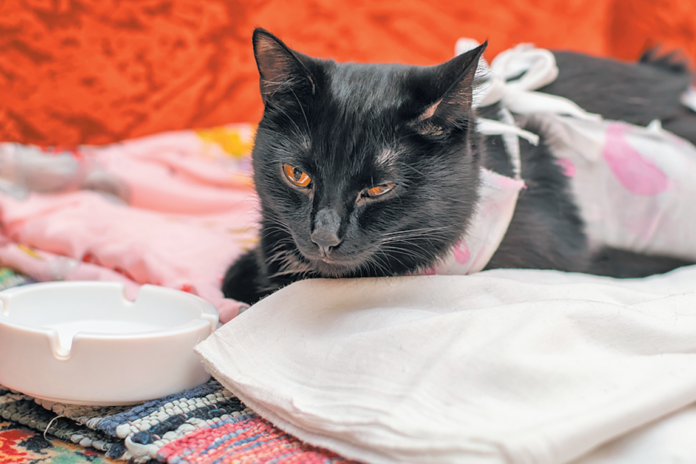Your cat’s heart disease has progressed to the point that there are no more medicines to try, no higher dosages to give, no more procedures to perform. Or her liver failure has reached a tipping point; toxins are building up in her body faster than they can be cleared. That is, the end is near. But it’s not quite here yet. Your pet can still enjoy some quality time before you need to make the unhappy decision to let her leave this world.
How do you keep your beloved pet comfortable when nothing else can be done to extend her life but it is not quite time to say good-bye, when she can still be kept relatively pain-free and enjoy being with you, if not all of the time, then at least some of it?
Turning to hospice for that “in between” time can be a hard decision to make. You’re letting go of aggressive efforts to treat a dire disease, to discontinue chemotherapy in the case of cancer, or other treatments for other diseases. That is, you’re letting go of hope that your cat can be cured or that her life can be extended with medical treatment. But the tradeoff you’re opting for has great value. It’s to focus on your cat’s quality of life right now, to give her the most comfort and emotional support you can in the little time she has left, whether it’s days, weeks, or even a month or two.
It’s an approach whose time has come. Hospice and the palliative care that’s part and parcel of it (“palliative” meaning to relieve symptoms, not to combat the disease itself) are endorsed by the American Association of Feline Practitioners, the American Veterinary Medical Association, the American Animal Hospital Association, and the International Association of Animal Hospice and Palliative Care.
What’s involved
There are essentially three main components to a hospice plan:
Medical care. This includes recognizing pain and other symptoms, such as nausea, dehydration, and mental distress; administering medications; anticipating complications; and learning what side effects may be associated with what treatments. A hospice vet should also be able to help you evaluate quality of life for your cat along the way so that all your decisions are informed ones.
Nursing care. This includes reviewing the treatments and medications administered daily as well as reviewing the cat’s activities of daily living; assessing her overall condition; and taking all measures necessary for maximizing her comfort.
Social work or family therapy. This means getting proper support for yourself as you go through the process of seeing your cat through to the end: making sure someone actively listens to you elaborate on your feelings, validates your experience, and facilitates coping and decision making. This could also include discussions of the cost to keep a cat alive balanced against the length of time gained and the quality of that extra time.
Ideally, a team of professionals will be involved in this multi-pronged effort: not just a veterinarian but also a veterinary technician (nurse), a social worker or other licensed professional, and in some cases a chaplain. But whatever help is available from a participating veterinary practice in your area, the most critical healthcare partner in your cat’s hospice care is you. The place where hospice happens is your home, so you have to be integrally involved in formulating an individualized plan for your cat. Moreover, although you are going to have help from your veterinarian’s office, it is going to fall largely upon you to be involved in the initiation of the plan and to see it through on a day-to-day and even an hour-by-hour basis.
For instance, you may be involved by administering medications, including giving shots (the vet will teach you how). Nursing efforts on your part could include specialized needs for toilet care. A cat who is unable to walk will need to be carried to the litterbox and be cleaned of urine from time to time with baby wipes and towels. Urine is very irritating to the skin.
Giving your cat hospice care does not mean she is going to die in her sleep. Very few cats succumb painlessly that way, so chances are that when the point comes that her pain-filled time is greater than her comfortable time, you will have to make the decision to actively take your pet out of her suffering. It’s always a miserable decision to have to make, but once you have chosen hospice care, you can reasonably choose to have your cat put down at home rather than take her to the doctor’s office. Why make her very last moments filled with stress when you have worked so hard to make her passage from life to death as comfortable as possible?
If a veterinarian comes to the house to perform the euthanasia, your cat can “go to sleep” right in one of her usual spots. The intimacy of the setting also allows you and your family to react in whatever way feels right rather than feel the need to stifle expressions of emotion as you pass other clients under the fluorescent glare of the office’s waiting room lights.
Considering cost
There’s a price for keeping your cat comfortable in the last phase of her life, even though you’ll be doing a lot of the work yourself. Teaching you how to perform tasks normally relegated to professional veterinary staff can be time- and labor-intensive. The veterinarian may have to make a number of visits to your home, and a vet tech may have to come by on an even more frequent basis.
But think of it this way. While a house call from a veterinarian can cost as much as $250, a single overnight stay in the hospital, with blood tests, frequent monitoring, and full-time professional staff could easily run to $500. In other words, once you’ve made the decision not to prolong your cat’s life but simply to work to make the life she has left as happy and comfortable as it can be, hospice care might reasonably come to be seen as a good financial deal.
The Nikki Hospice Foundation (pethospice.org) says that hospice care allows for a “good” death as well as for “good” grieving. It’s a lot easier to begin saying good-bye to your feline companion in the warmth and comfort of your own home rather than in the relatively sterile environment of a doctor’s office or hospital.




